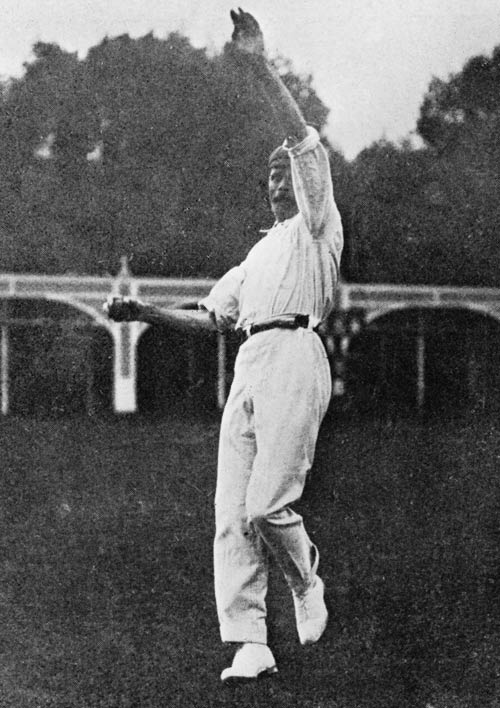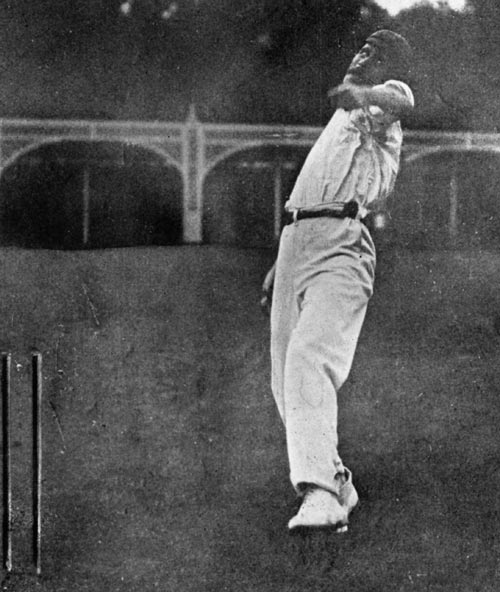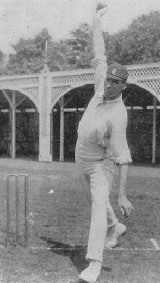zaremba
Cricketer Of The Year
From Ralph Barker's 10 Great Bowlers:
When he began his first-class career in the mid-1890s "he was a tearaway fast bowler".
In 1901 when he returned to first-class cricket: "In seven seasons of league cricket Barnes had developed into a fast-medium bowler of rare control and ability. Tall, lean and upright, he had a bouncy run-up of moderate length, beginning with a few short steps, then accelerating into big, swinging strides that developed into leaps before he delivered the ball. As he leapt into his last stride, the ball held out waist high, he began the unusually long, loose, circular swing of the arm from which he got most of his pace. He did not put much body weight into his action, nor did he get any significant power from the bend of his back. But he made full use of the impetus he gathered during his run-up to the wicket, his actual delivery was a model of co-ordination, and his arm was as high as it could possibly be.
"In his early days as a fast bowler, Barnes had been shown how to bowl the fast off-break. But he had realised that a fast leg-break would be even more difficult to play. His idea was to deliver the leg-break from the same height and with the same trajectory as the off-break digging it in instead of tossing it up in the manner of the orthodox leg-spinner, and he worked on it and found he could bowl it just as accurately as the off-break. For both balls he gripped the ball in three fingers, the second finger over the top, the first and third spread on either side, so that the manner of delivery was the same; both leg-break and off-break were whipped down from the full extent of his reach, whether he was imparting off spin, mainly with the third finger, or leg spin, mainly with the third. Thus batsmen were in doubt what to expect until the ball actually left the hand, and were not always certain even then.
"Barnes had long, powerful fingers with which he worked the ball in a manner unusual for a pace bowler. Indeed there is a body of confident opinion that the muscular structure of his wrist and forearm must have been freakish, enabling him to bowl the leg-break as his natural ball. Some reversal of the natural muscular structure would be confirmed if Barnes could be shown to have had difficulty in bowling the off-break; and this may very well have been so. In answer to a criticism of Plum Warner's that he hardly ever used the off-break he promptly bowled him with one, but the story goes some way to confirming the theory. It may well be, though, that the answer lies purely and simply in finger strength.
"In addition to movement off the wicket, Barnes moved the ball a great deal in the air. But whereas the swing bowler moves off the wicket in the same direction as through the air, Barnes, as a swerve bowler - a man who always spun the ball - was apt to make the ball swing one way and break the other... He seems to have been physically incapable of delivering the ball without imparting spin, and as long as the ball was spinning there was always the chance that it might move one way in the air, bite as it pitched, and come back the other.
"Spin, bounce and nip off the pitch, allied to a late and disconcerting swerve, projected at every pace from fast to slow-medium, made Barnes at the age of twenty eight the complete bowler. Undeniably, though, the fast leg-break, rare if not actually unique, pitching on the leg stump and hitting the off, or finding the outside edge, was his best ball."
Before leaving for his first tour of Australia "he described his speed in [an] interview as 'medium to fast'. In fact, when he got to Australia, he found it paid him best on Australian wickets to bowl as fast as he could while still retaining control. He was not the tearaway bowler that he had been in his early twenties, but he was still fast enough to be able to make them bump when he shortened his length."
On the 1906/7 tour to Australia "Barnes had lost some of his pace since his earlier visit to Australia, but the Australians believed he was even more effective, and he was still bowling virtually as fast as he could."
Barker describes his performance in Melbourne in December 1911 in detail. In the course of this he notes that Barnes "was no longer fast, and Smith at the wicket was able to stand up for him although he had stood back for Foster, but he still put every ounce of his energy into each ball. Apart from occasional variations of pace, that was how he always bowled in Australia...
"Barnes' third over was bowled to Clem Hill, then the best left-handed batsman in the world. No two balls in the over were alike. There was the fast leg-break (an off-break to Hill), the in-swinger, the top-spinner, and the one going away. Finger-spin, seam, swerve - the permutations were inexhaustible. Hill hardly got his bat on any of them. This was the softening-up process, and now Barnes was poised for the kill. He chose to try a ball that he rarely bowled effectively - the break-back, the ball that, to the right-hander, whipped back off the pitch from the off. It was aimed just on or outside Hill's leg stump and appeared to be swinging even further down the leg side, so that Hill prepared to push it away. But as the ball pitched it spun back, and before Hill could get his bat across to it his off stump had gone."
When he began his first-class career in the mid-1890s "he was a tearaway fast bowler".
In 1901 when he returned to first-class cricket: "In seven seasons of league cricket Barnes had developed into a fast-medium bowler of rare control and ability. Tall, lean and upright, he had a bouncy run-up of moderate length, beginning with a few short steps, then accelerating into big, swinging strides that developed into leaps before he delivered the ball. As he leapt into his last stride, the ball held out waist high, he began the unusually long, loose, circular swing of the arm from which he got most of his pace. He did not put much body weight into his action, nor did he get any significant power from the bend of his back. But he made full use of the impetus he gathered during his run-up to the wicket, his actual delivery was a model of co-ordination, and his arm was as high as it could possibly be.
"In his early days as a fast bowler, Barnes had been shown how to bowl the fast off-break. But he had realised that a fast leg-break would be even more difficult to play. His idea was to deliver the leg-break from the same height and with the same trajectory as the off-break digging it in instead of tossing it up in the manner of the orthodox leg-spinner, and he worked on it and found he could bowl it just as accurately as the off-break. For both balls he gripped the ball in three fingers, the second finger over the top, the first and third spread on either side, so that the manner of delivery was the same; both leg-break and off-break were whipped down from the full extent of his reach, whether he was imparting off spin, mainly with the third finger, or leg spin, mainly with the third. Thus batsmen were in doubt what to expect until the ball actually left the hand, and were not always certain even then.
"Barnes had long, powerful fingers with which he worked the ball in a manner unusual for a pace bowler. Indeed there is a body of confident opinion that the muscular structure of his wrist and forearm must have been freakish, enabling him to bowl the leg-break as his natural ball. Some reversal of the natural muscular structure would be confirmed if Barnes could be shown to have had difficulty in bowling the off-break; and this may very well have been so. In answer to a criticism of Plum Warner's that he hardly ever used the off-break he promptly bowled him with one, but the story goes some way to confirming the theory. It may well be, though, that the answer lies purely and simply in finger strength.
"In addition to movement off the wicket, Barnes moved the ball a great deal in the air. But whereas the swing bowler moves off the wicket in the same direction as through the air, Barnes, as a swerve bowler - a man who always spun the ball - was apt to make the ball swing one way and break the other... He seems to have been physically incapable of delivering the ball without imparting spin, and as long as the ball was spinning there was always the chance that it might move one way in the air, bite as it pitched, and come back the other.
"Spin, bounce and nip off the pitch, allied to a late and disconcerting swerve, projected at every pace from fast to slow-medium, made Barnes at the age of twenty eight the complete bowler. Undeniably, though, the fast leg-break, rare if not actually unique, pitching on the leg stump and hitting the off, or finding the outside edge, was his best ball."
Before leaving for his first tour of Australia "he described his speed in [an] interview as 'medium to fast'. In fact, when he got to Australia, he found it paid him best on Australian wickets to bowl as fast as he could while still retaining control. He was not the tearaway bowler that he had been in his early twenties, but he was still fast enough to be able to make them bump when he shortened his length."
On the 1906/7 tour to Australia "Barnes had lost some of his pace since his earlier visit to Australia, but the Australians believed he was even more effective, and he was still bowling virtually as fast as he could."
Barker describes his performance in Melbourne in December 1911 in detail. In the course of this he notes that Barnes "was no longer fast, and Smith at the wicket was able to stand up for him although he had stood back for Foster, but he still put every ounce of his energy into each ball. Apart from occasional variations of pace, that was how he always bowled in Australia...
"Barnes' third over was bowled to Clem Hill, then the best left-handed batsman in the world. No two balls in the over were alike. There was the fast leg-break (an off-break to Hill), the in-swinger, the top-spinner, and the one going away. Finger-spin, seam, swerve - the permutations were inexhaustible. Hill hardly got his bat on any of them. This was the softening-up process, and now Barnes was poised for the kill. He chose to try a ball that he rarely bowled effectively - the break-back, the ball that, to the right-hander, whipped back off the pitch from the off. It was aimed just on or outside Hill's leg stump and appeared to be swinging even further down the leg side, so that Hill prepared to push it away. But as the ball pitched it spun back, and before Hill could get his bat across to it his off stump had gone."
























